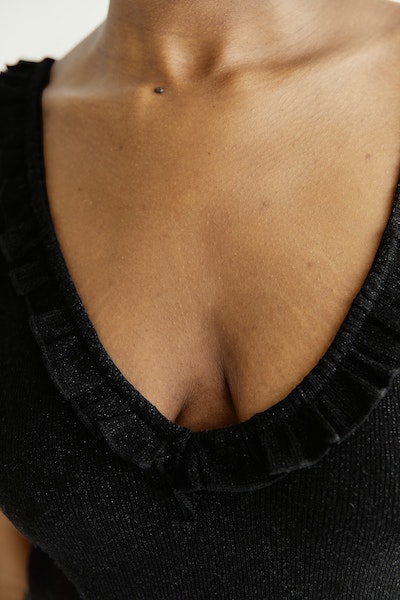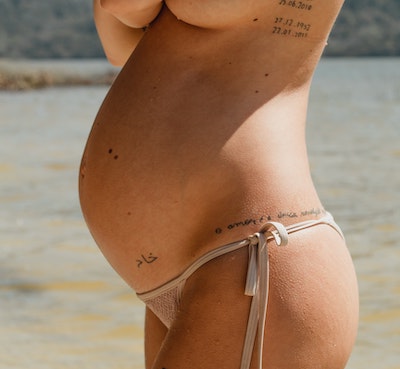You’ve just got pregnant and you’re wondering if you are going to have pregnancy stretch marks? Or maybe you’re now healing from giving birth and you’re concern if the stretch marks on your belly are ever going to go away?
You’re in the right place! In this article you’ll find out everything you should know about stretch marks in pregnancy: from caused to prevention and treatment.

Stretch marks are like unavoidable honor badges of pregnancy, with 8 to 9 out of 10 expectant mothers developing vertical lines running down the abdomen, as well as breasts, thighs, hips and buttocks.
Pregnancy stretch marks or striae gravidarum, as they are also called, are not harmful to the mother or the baby.
The silvery lines you see are only a skin condition that may also occur during adolescence when your body grows quickly. Medical problems can also cause this condition.
While it may not be possible to prevent stretch marks entirely, you can lighten them.
Just as you’re reading up on how to care for your newborn, you may also want to research into taking care of your body and skin all through pregnancy and postpartum.
Managing striae stretch marks is an important part of it.
So, read ahead to know more about when do stretch marks appear in pregnancy and how to deal with them.
This article is not a substitute for medical advice.
What Causes Stretch Marks During Pregnancy?
Your skin is an incredibly elastic and stretchable organ. The connective tissues in the layers of the skin are made with collagen and elastin that lend flexibility and bounce.
While the skin can move and stretch with every movement you make, it needs time to grow. During pregnancy, you’ll gain weight rapidly, and the skin has a tough time keeping up.
You can expect to gain around 22 to 35 lbs in just 9 months.1
The baby is growing fast, and the skin on your belly (as well as thighs and bum) stretches a lot. It’s the same for your breasts – which get bigger during pregnancy and later on get filled with milk.

Hormonal changes could contribute to striae stretch marks. That’s because pregnancy hormones relax the bonds between collagen fibers, causing them to tear, which in turn leads to stretch marks.2
What Is A Stretch Mark?
As a result of the rapid growth and stretching too far, the dermis (middle layer of skin) in pregnant women develops tears, and the deepest layer of skin – hypodermis starts to show through. This is how stretch marks form.
The white lines you see is actually the hypodermis layer visible through tears in dermis.
What Week Of Pregnancy Do Stretch Marks Appear?
Lots of pregnant women wonder ”When do stretch marks appear in pregnancy?”. You need to keep in mind that you can’t really predict it since several factors come into play when it comes to stretch mark appearance.
Individual body structures, the amount of weight you gain, genetics, and the elasticity of your skin can influence striae.
Developing stretch marks in the first trimester is common because of rapid weight gain, while others start to notice them late in the second trimester.
If you’re exceptionally thin, you might see more of the marks appearing sooner.
Around 80% to 90% of women are likely to develop striae pregnancy stretch marks in the sixth or seventh month.
Then again, following a nutritious diet with your doctor’s advice and ensuring that the weight gain is gradual could help in preventing stretch marks.
Women can use several other tips to reduce the appearance of silvery lines, during pregnancy and postpartum. But more on that later.

Where Do Stretch Marks Appear During Pregnancy?
Since your stomach tissues are expanding to accommodate the growing baby, you’ll likely to notice first stretch mark on your belly. As the baby continues to grow, more of the vertical lines around the navel will appear and start to extend to the flanks.
Again, depending on the amount of weight gain, some women develop stretch marks on their lower back, hips, buttocks, and thighs.
Since your body is preparing your breasts to nourish the infant, they also start to swell. So, prepare to see a few stretch marks forming around the breasts, and even on the upper arm.
Stretch marks and scars will appear primarily in areas where there are large fat deposits and where the skin stretches beyond its elasticity.
What Do Pregnancy Stretch Marks Look Like?
The exact coloring and appearance of the striae depend on your skin tone and how much the skin stretches.
Lighter skin tones show pinkish marks, while darker skin tones display lighter shades. Expect a selection of colors ranging from pink and red to purple or even brown.3

On the onset, you’ll see pink marks that feel itchy. As the pregnancy progresses, the stretch marks tend to widen and appear reddish or purple. These tones fade over time as the skin matures.4
Post-pregnancy, as the dermis regains its tautness, the marks remain as silvery lines. Some of the lines could be deeper, like grooves, but usually not dramatically visible.
Can You Prevent Stretch Marks During Pregnancy?
Well, you can’t really avoid developing pregnancy stretch marks entirely. But, you can take care of your skin and nourish it, so you have fewer marks that are less visible.5 Check out these tips for healthy skin:
- Drink lots of water.
Keeping your body hydrated all through your pregnancy is great for you and the growing baby’s health. Water keeps your tissues moisturized and adds to their suppleness, so they stretch more easily without tearing.
- Massage your baby bump with organic oils.
Massages promote blood flow to the dermis, while the oil hydrates and breaks down scar tissue as it forms.
You can try stretch mark belly oils with coconut or olive oil, other pregnancy-safe products enriched with hyaluronic acid, vitamin E and C, cocoa butter or shea butter to moisturize your skin.
Make sure to check with your doctor since the products can enter your bloodstream through the pores.
- Resist the urge to scratch.
When the skin is stretched, the itchiness becomes unbearable. Although it is incredibly hard, you must avoid scratching.
Apply some soothing oils or belly creams and smooth over the inflamed areas. Wearing loose clothing with a layer of soft cotton next to your tummy will also help.
- Look for specialized creams for pregnancy stretch marks with the advice of your doctor.
These creams and salves contain ingredients like beeswax, avocado peptides, and sunflower seed oil. Applying raw aloe vera gel also helps, and since it is pure, you won’t have to worry about any possible ill effects on the baby.
- Eat a nutritious diet.
Opt for a diet with lots of fruits and vegetables, particularly rich in vitamin C and amino acids that are the tissue building blocks. Taking oral vitamins also helps.
Does Every Woman Get Stretch Marks During Pregnancy?
As explained above, statistically, 80% to 90% of women develop stretch marks.6
And, yes, genetics and skin type do play a critical role.7 You might want to check with your mom, sister, or aunts. Chances are that if they have motherhood scars, you’ll probably get them too.
But, taking the necessary precautions can help you lower their appearance.

Is It Possible To Not Get Stretch Marks In Pregnancy?
If you are one of the lucky 10% of women on the planet with exceptionally elastic tissues, you might be able to get away with a smooth belly. Good for you!!
Do Stretch Marks From Pregnancy Go Away?
Unfortunately, stretch marks from pregnancy do not go away on their own, at least not entirely. Over time, as you lose the pregnancy flab and the belly skin returns to its previous state, the stretch marks will lighten.
You might notice only silvery lines, though some of the grooves will remain. Consider the marks as scar tissue, similar to what you might see after an injury or surgery.
However, by taking the necessary preventive steps, you can help prevent and minimize damage, so there is less scarring and striae.
Moisturizing your stretched skin after giving birth with a good body lotion may also help to make the scars fade a bit quicker.
Keep in mind that you may not be able to get rid of each stretch mark from your bump, but with time and proper skin care routine you can reduce their visibility.

How To Remove Stretch Marks After Pregnancy?
If you want to get rid of stretch marks, several options are available to you after birth.
However, as your pediatrician will advise, you might want to wait until your baby is weaned and you’re no longer breastfeeding.
Any products you use could seep into the bloodstream and breast milk. Further, take this time to exercise to get back in shape and tone the belly muscles.
Once your stomach is back to normal, you can consider options like:
- Applying organic salves that contain healing ingredients like peptides, or fruit, flower, and vegetable extracts.
- Exfoliating gently to brush away dead skin, allowing new skin to emerge.
- Laser therapy and light therapy resurfacing sessions from an expert dermatologist to break down tough scar tissue, and let new skin emerge.8
- Treating the affected skin with tretinoin and hyaluronic acid applications for skin repair.
- Getting microneedling sessions to stimulate the production of collagen and elastin under the skin.9
- Platelet Rich Plasma injections to promote healing. This technique can be combined with microneedling for more effective results.
The purpose of this article is informative. It’s not a substitute for professional medical advice or medical care. Remember: safety first! Consult your doctor/pediatrician in case of any doubts. The author of this article does not accept any responsibility for any liability, loss or risk, personal or otherwise, incurred as a consequence, directly or indirectly, from any information or advice contained here.

